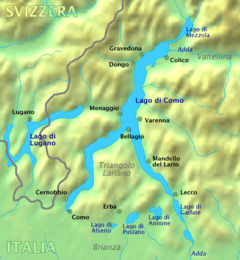Blevio
| Blevio Biev (Lombard) | ||
|---|---|---|
| Comune | ||
| Comune di Blevio | ||
 Central Blevio seen from the lake | ||
| ||
 Blevio Location of Blevio in Italy | ||
| Coordinates: 45°50′20″N 9°06′09″E / 45.8389°N 9.1024°ECoordinates: 45°50′20″N 9°06′09″E / 45.8389°N 9.1024°E | ||
| Country | Italy | |
| Region | Lombardy | |
| Province | Como (CO) | |
| Government | ||
| • Mayor | Raffaello Caccia | |
| Area | ||
| • Total | 5.9 km2 (2.3 sq mi) | |
| Elevation | 231 m (758 ft) | |
| Population (31 December 2010)[1] | ||
| • Total | 1,268 | |
| • Density | 210/km2 (560/sq mi) | |
| Demonym(s) | Bleviani | |
| Time zone | UTC+1 (CET) | |
| • Summer (DST) | UTC+2 (CEST) | |
| Postal code | 22020 | |
| Dialing code | 031 | |
Blevio (Comasco: Biev [ˈbjeːf]) is a comune (municipality) in the Province of Como in the Italian region Lombardy, located about 40 kilometres (25 mi) north of Milan and about 2 kilometres (1 mi) northeast of Como. It overlooks the eastern shore of Lake Como from hilly slopes starting at more than 200 metres (660 ft).
Blevio borders the following municipalities: Brunate, Cernobbio, Como, Moltrasio, Torno.
History
The comune of Blevio includes seven villages, the so-called "the seven cities" (Capovico, Cazzanore, Girola, Maggianico, Mezzovico, Sopravilla, Sorto), the most important of which was that close to Como Lake. The municipal land extends from 200 to 1,140 metres (660 to 3,740 ft) above sea level.
The etymology of the name of the city could be found in the Celtic Ligurian "Biuelius" (Latin "vivo – alive", Welsh "byw", old Irish "biu – I use to be" and Anglo-Saxon "beo – I am, I become", Indo-Germanic "bheou").
In 1497, the ruleer of Milan, Ludovico Sforza, known as Il Moro, gave the fief of Blevio, together with some other near villages, to his lover, the beautiful dame Ludovica Crivelli. In the following centuries, Blevio became closely linked to the main city of Como and finally became a fief of the Edler von Tanzi patrician family, whose wealth generated from the silk industry. Count Antonio von Tanzi Blevio built a magnificent villa on the rocks of Perlasca, now part of the neighbour town of Torno. In 1798, the village became a possession of the Taverna and Borromeo families, two of the most renowned and affluent families of the Milanese aristocracy, before being created as a free town under Napoleon I.
External links
- https://web.archive.org/web/20070821062928/http://www.blevioinlinea-glv.it/index.htm -
- http://maps.google.it/maps?oi=eu_map&q=Blevio&hl=it -
- https://web.archive.org/web/20071217045759/http://www.passolento.it/erratici.htm –
- https://web.archive.org/web/20070716051017/http://www.archeologicacomo.org/main.html?cat=4&scheda=47%23
- https://web.archive.org/web/20060508105923/http://www.cmtl.it/images/cartina.jpg


